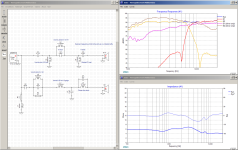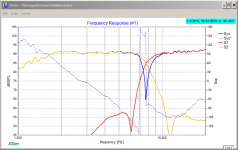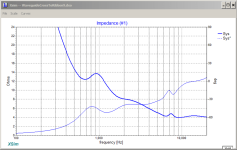Has anyone had any experience with the Neville Thiele Crossover, which has notched responses? It is described in the attached US patent (which has expired).
He did a magnificent job of considering phase response and input impedance. His approach can yield a steeper transition than a 4th-order L-R crossover while using the same number of components, at least in the passive versions.
I am considering designing a system using them for my ongoing Klipshorn upgrade project. The KHorn's lower frequency "expiration" point is close to the crossover frequency, so care must be taken not to blow the driver.
I also expect they would have a broad application with direct radiator speakers; I do not know of anyone using them commercially.
Thoughts are appreciated! I think they are worth a look.
He did a magnificent job of considering phase response and input impedance. His approach can yield a steeper transition than a 4th-order L-R crossover while using the same number of components, at least in the passive versions.
I am considering designing a system using them for my ongoing Klipshorn upgrade project. The KHorn's lower frequency "expiration" point is close to the crossover frequency, so care must be taken not to blow the driver.
I also expect they would have a broad application with direct radiator speakers; I do not know of anyone using them commercially.
Thoughts are appreciated! I think they are worth a look.
Attachments
The Neville Thiele Crossover response is steeper than a LR/4 in the octave below the crossover frequency, and less steep than a LR/2 an octave below, where excursion demands are highest.His approach can yield a steeper transition than a 4th-order L-R crossover while using the same number of components, at least in the passive versions.
Looking at the response, I can't think of any commercial (or DIY) speaker application (direct radiator, front loaded horn, back loaded horn, tapped horn multiple entry horn) that would benefit from a response as depicted in the patent's Figure 6.I do not know of anyone using them commercially.
If the acoustic response of a driver happened to have a high Q peak that corresponded to the notch in the crossover, I'd probably not want to use it 😉
In column 18, section 45 the patent states:
"Although their performance in lobing with non-coincident drivers has not been examined specifically, it is expected to be similar to that of the Linkwitz-Riley crossovers.."
Great expectation, but appears Thiele (RIP) and the patent assignee never found any takers for this approach.
Art
I got the KHorns new in 1985. The original crossovers looked a bit of a hodgepodge, which was sad. It looks like they cheap out on their crossovers, even on some of the higher-end units.🙁
Until recently, ALK Engineering produced some aftermarket crossovers that he deemed "extreme slope," designed for the KHorns and LaScalas. They got a lot of positive reviews—and were very expensive. He has since retired, and it appears that his crossovers have gone away. He will not release the plans, so I expect that is a dead end. He does have plenty of technical data about their performance, and curiously, the return value is about -20 dB or so as opposed to the -30 dB or so of the Thiele designs. They did have a much steeper transition in the crossover region.
Another goal that I failed to mention before: On the KHorns, there is a very large acoustical path length difference between the bass horn and the midrange—about 6'. This tends to create a spatial area in front of the speakers where there is phase cancellation, which messes with the frequency response. By making the crossover region smaller, the band of frequencies where this occurs will also be smaller. At least, that is the justification given by ALK.
For me, this is one stop on the path, mainly to satisfy my curiosity and have some fun. When I get the time to spin up a DSP board, I plan to go full tri-amp with DSP.
On a side note, Thiele did some other amazing work on crossover and inductor design. It's too bad he is only known for the T_S parameters for box design.
Thanks for the feedback.
Until recently, ALK Engineering produced some aftermarket crossovers that he deemed "extreme slope," designed for the KHorns and LaScalas. They got a lot of positive reviews—and were very expensive. He has since retired, and it appears that his crossovers have gone away. He will not release the plans, so I expect that is a dead end. He does have plenty of technical data about their performance, and curiously, the return value is about -20 dB or so as opposed to the -30 dB or so of the Thiele designs. They did have a much steeper transition in the crossover region.
Another goal that I failed to mention before: On the KHorns, there is a very large acoustical path length difference between the bass horn and the midrange—about 6'. This tends to create a spatial area in front of the speakers where there is phase cancellation, which messes with the frequency response. By making the crossover region smaller, the band of frequencies where this occurs will also be smaller. At least, that is the justification given by ALK.
For me, this is one stop on the path, mainly to satisfy my curiosity and have some fun. When I get the time to spin up a DSP board, I plan to go full tri-amp with DSP.
On a side note, Thiele did some other amazing work on crossover and inductor design. It's too bad he is only known for the T_S parameters for box design.
Thanks for the feedback.
Do you know why this response problem happens? Is it delay related phase shift or mouth related secondary radiation?This tends to create a spatial area in front of the speakers where there is phase cancellation, which messes with the frequency response. By making the crossover region smaller, the band of frequencies where this occurs
I sometimes use notched filters to track LR8 or other higher order initial slopes. It's relatively rare but far from unknown. In effect it's a Chebyshev type 2 type filter, or network-synthesis equivalent of Zobel's image-impedance based M-derived networks. Providing the stopband ripple is sufficiently attenuated, it can work well; the transition to 2nd order attenuation below that for HP networks shouldn't be an issue in a well-designed example, a/ because the driver is already very heavily suppressed, and b/ for filter orders > 2nd, the point of maximum excursion for a given power input is above, not below, the crossover frequency. That has its own challenges for higher order filters, since power-handling / distortion requirements in that region are greater than, say, LR4, quasi-LR3 etc. as the transition band is narrower & the HF / smaller driver is staying flatter to a lower frequency. But that applies whether it's a notched / Chebyshev / Cauer (sort of), a conventional non-notched ladder or whatever.
Last edited:
Yes, the NTM is a sort of Cauer-elliptical xover method. The closer the notch to the xover point, the higher the ripple is outside the xover immediate range. The further away, the less ripple results.
John Hollander used this method in his Seriatim build, and they sounded very good indeed.
John Hollander used this method in his Seriatim build, and they sounded very good indeed.
Ioseph Audio (https://www.josephaudio.net/products) are using them in all of their models. Actually, they are using Richard Modafferi's patented "Infinity Slope" passive crossover which is very similar to the Nevile Thiel's patent.I do not know of anyone using them commercially.
Last edited:
I use the NTM filters on dsp from BSS 366T in 36db slope and compare with my FIR dsp don t know what it is but sounds better to my ears the NTM.Compare the LR filters on the same unit again wins the NTM. Both dsp units are feeded with digital aes/ebu input.
The precursor of the NTM is probably in the article by Hardman
published in August 1999 issue of english Electonics Word.
It was mentionned in DiyAudio in october 2002 here
published in August 1999 issue of english Electonics Word.
It was mentionned in DiyAudio in october 2002 here
The Best Active Crossover - Here!
https://www.diyaudio.com/community/threads/the-best-active-crossover-here.6655/#post-68889With active, sure. Passive versions go back to Zobel's M-derived network (albeit different analysis method / assumptions) and subsequently Richard Modafferi's predecessor to his 'infinite slope' notched / Type II dating from the mid-late '80s. Jason Cuadra revived it back around '99, sans the transformers of the infinite slope; he even remarked on that part, probably without realising it was an update to Modafferi's original patent.
Last edited:
There are lots of great thoughts. I had looked at the Hardman crossover but did not pursue it because I wanted my first foray to be a passive design. I also looked at Modafferi's material. Interestingly, what he proposed as his invention in the patent was actually given as a homework problem in an old electrical engineering textbook!
For the KHorns, the interference patterns result from the huge difference in acoustic path length from the radiating surface to the front of the speaker. The distance from the diaphragm of the midrange horn is about 24" (+/-); from the woofer cone, it is nearly 96". With the mild roll-off of the stock crossovers, I get a null in frequency response at about 320 HZ.
For the KHorns, the interference patterns result from the huge difference in acoustic path length from the radiating surface to the front of the speaker. The distance from the diaphragm of the midrange horn is about 24" (+/-); from the woofer cone, it is nearly 96". With the mild roll-off of the stock crossovers, I get a null in frequency response at about 320 HZ.
This is one of the issues with patents. a/ They don't have to work, just be original. And b/ they often aren't even original except in terms of detail phrasing and in those cases would never stand up to challenge if the assignee attempted to apply them more broadly, but are there more for the marketing value. Which doesn't mean some don't contain good work of course. As far as these notched filters go, for crossover work the real key to using them is to initially track a given high order slope, be it Linkwitz or whatever, same as any other type.
Funny this should come up now: last week I finished a crossover for a 7.8 kHz transition from a tweeter to a supertweeter. One really wants minimum overlap between the drivers since path length differences in the vertical plane will cause interference. Since a half-wavelength at 8 KHz is 0.85 inches (2.2 cm), with drivers a few inches (say about 10 cm between centres) apart a null will be observed around the crossover point at 12-13 degrees above or below axis. This needn't be too deleterious provided the notch is narrow enough, so dropping off sharply after crossover is useful.
The first picture shows the crossover network. It's a bit baroque, 5th order for the supertweet and 3rd order for the tweeter [1]. L6/C3 provide the notch for the supertweet, which is 35 dB down at a third-octave below 8K, and rolls off at the expected 24 dB/octave below 4 kHz. Meanwhile C7/L2 provide the tweeter notch a bit further away, which isn't as critical since that driver already rolls off slightly below xover anyway, and we're not concerned with excursion at high frequencies. The brown and magenta curves are the raw driver responses, yellow and red are drivers in circuit, and the blue curve is the system response.
The second picture zooms in (note scale) on the sum: the summed response is almost identical to in-circuit driver response not very far away from 7.8 kHz, which shows how little contribution is made away from the crossover. Phase response is within shouting distance of linear, more than adequate at high frequencies.
The third picture zooms out to show nulling when one of the drivers is out of phase, which also shows the worst case off-axis response.
L7/R2 flatten the impedance response and reduce the impedance phase angle from 40-odd degrees below 5 kHz to a far more benign range of 2 to 18 degrees. Picture 4 shows impedance and phase without L7/R2.
[1] L5/C8/R3 are for response shaping so they're not really part of the crossover order, and C6 is for protection in case of amplifier failure.
The first picture shows the crossover network. It's a bit baroque, 5th order for the supertweet and 3rd order for the tweeter [1]. L6/C3 provide the notch for the supertweet, which is 35 dB down at a third-octave below 8K, and rolls off at the expected 24 dB/octave below 4 kHz. Meanwhile C7/L2 provide the tweeter notch a bit further away, which isn't as critical since that driver already rolls off slightly below xover anyway, and we're not concerned with excursion at high frequencies. The brown and magenta curves are the raw driver responses, yellow and red are drivers in circuit, and the blue curve is the system response.
The second picture zooms in (note scale) on the sum: the summed response is almost identical to in-circuit driver response not very far away from 7.8 kHz, which shows how little contribution is made away from the crossover. Phase response is within shouting distance of linear, more than adequate at high frequencies.
The third picture zooms out to show nulling when one of the drivers is out of phase, which also shows the worst case off-axis response.
L7/R2 flatten the impedance response and reduce the impedance phase angle from 40-odd degrees below 5 kHz to a far more benign range of 2 to 18 degrees. Picture 4 shows impedance and phase without L7/R2.
[1] L5/C8/R3 are for response shaping so they're not really part of the crossover order, and C6 is for protection in case of amplifier failure.
Attachments
@Scottmoose If memory serves, Joseph Audio was famous for those very high slope crossover though they seem to have turned away from them last time I looked. Not sure what this says about the overall value of the technology in the marketplace.
In the next few days, I plan to do a sensitivity analysis for component values for the NTM Crossover vs. an L-R 4th order and see how realistic it is to actually build. I know that the ALK Engineering designs were very critical re part values.
A steeper crossover can minimize the overlap region, but won't change the time alignment issues the acoustical path length difference creates.Another goal that I failed to mention before: On the KHorns, there is a very large acoustical path length difference between the bass horn and the midrange—about 6'. This tends to create a spatial area in front of the speakers where there is phase cancellation, which messes with the frequency response. By making the crossover region smaller, the band of frequencies where this occurs will also be smaller.
The type of crossover used can't change the bifurcated and divergent paths of the left and right bass horn outputs, which are separated by around a wavelength at the acoustic crossover.
A passive crossover can be made to provide "in phase" response through the acoustic crossover region on axis for the Khorn, but can't correct the off axis room response.
The impedance response of your drivers will not be close to the purely resistive termination the NTM crossover assumes.In the next few days, I plan to do a sensitivity analysis for component values for the NTM Crossover vs. an L-R 4th order and see how realistic it is to actually build.
The impedance of the woofers depend on the particular room loading, your left and right speakers may not be the same, though may resemble the impedance/phase chart above.
Depends on how they were actually defining high slope; most of the measurements I've seen for e.g. suggest they haven't been running much out of the ordinary for the last decade or so, and the earlier examples e.g. RM7 don't look especially well optimised to my eyes. The issue with filters like these tends to be the relatively large component count -even though it's smaller than you'd get by just buidling a ladder, size / cost is high since you need close tolerances & generally low DCR inductors, and they take up a fair amount of space too. I'd also generally say they're only worth it if you're crossing relatively low -as frequency rises, so alternatives start to make as much / more sense. That last is purely my opinion of course, so given FWIW (not a lot) only.@Scottmoose If memory serves, Joseph Audio was famous for those very high slope crossover though they seem to have turned away from them last time I looked. Not sure what this says about the overall value of the technology in the marketplace.
most of the measurements I've seen for e.g. suggest they haven't been running much out of the ordinary for the last decade or so, and the earlier examples e.g. RM7 don't look especially well optimised to my eyes
I thought as much too. Thanks!
Well I actually flew (with) the Joseph RM7XL (and Morel Renaissance Duet and Lowther PM6A drivers, on separate trips), back when I moved to Beijing for work. The RM7XL were definitely not "infinite slope" -- conflicting reports of 2nd-order or something involving 3rd. I bought mine used/unheard and now believe they had tweeters changed at the factory -- Stereophile reviewed a too-bright HF but mine were rolled-off (brass instrument tonality wrong) -- but discovered too late. Anyway they did somethings well but bass did not go deep, compared to my 3.75L TLonken Maeven final version.
https://www.diyaudio.com/community/...ir-5-2-in-evansound-3-75l.393909/post-7219809
https://www.diyaudio.com/community/...ir-5-2-in-evansound-3-75l.393909/post-7219809
- Home
- Loudspeakers
- Multi-Way
- Neville Thiele Crossover



